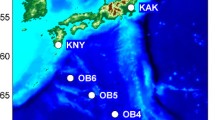Summary
Insidious errors in dipole modeling due to shell model misspecification in a spherical model were examined analyzing multiple time-points using the constraints of a commonly-used DSL (Dipole Source Localization) method. The computer simulation examined the differences in the fit dipole parameters for the same generator under two circumstances: 1) when computed as a single dipole active alone, and 2) when computed as a member of a simultaneously-active dipole pair. The computations were done using a simplification by which the dipole parameters computed from multiple time-points can be correctly assessed by computing dipole parameters at only two virtual time-points. Using multiple time-points in the DSL generally resulted in less error than if only a single time-point was used. However, how much improvement can be achieved by using multiple time-points, as compared with a single time-point, is a function of many factors, such as the location and orientation of the dipoles, and the relative magnitudes and overlap of the waveforms (i.e., time-varying magnitudes) of the dipoles, as well as the model used in the fitting. Further, it was shown that it is incorrect to assume that a multiple-time-point DSL will compute a zero magnitude for generators during quiescent intervals. Additionally, it was shown that a “correction” to reduce error for one pair of waveforms will not be applicable to other waveforms. Also, even if location errors are eliminated, magnitude and orientation errors can still be shown to be present. Finally, iterative reduction of the least-square error between the observed and predicted surface maps leads to increasing errors in dipole parameters. We conclude that a DSL with model misspecification can contain insidious (undetectable) errors.
Similar content being viewed by others
References
Ary, J.P., Klein, S.A. and Fender, D.H. Location of sources of evoked scalp potentials: corrections for skull and scalp thicknesses. IEEE Trans. Bio-med. Eng., 1981, 28: 447–452.
Amir, A. Uniqueness of the generators of brain evoked potential maps. IEEE Trans. Bio-med. Eng. (in press, 1994).
Bishop, G.H. Potential phenomena in thalamus and cortex. Electroenceph. clin. Neurophysiol., 1949, 1: 421–436.
Brazier, M.A.B. A study of the electrical field at the surface of the head. Electroenceph. clin. Neurophysiol., 1949, 2 (Suppl): 38–52.
de Munck, J.C. The estimation of time varying dipoles on the basis of evoked potentials. Electroenceph. clin. Neurophysiol., 1990, 77: 156–160.
Fender, D.H. Source localization of brain electrical activity. In: Gevins and Remond (Eds.), Methods of Analysis of Brain Electrical and Magnetic Signals. Elsevier Science Pub. New York. 1987: 355–403.
Jewett, D.L. and Deupree, D.L. Far-field potentials recorded from action potentials and from a tripole in a hemicylindrical volume. Electroenceph. clin. Neurophysiol., 1989, 72: 439–449.
Jewett, D.L., Deupree, D.L. and Bommannan, D. Far-field potentials generated by action potentials of isolated frog sciatic nerves in a spherical volume. Electroenceph. clin. Neurophysiol., 1990, 75: 105–117.
Kavanagh, R.N., Darcey, T.M. and Fender, D.H. The dimensionality of the human visual evoked scalp potential. Electroenceph. clin. Neurophysiol., 1976, 40: 633–644.
Landau, W.M. Evoked potentials. In: G.C. Quarton, T. Mel-nechuk and F.O. Schmitt (Eds.), The Neurosciences-A Study Program. Rockefeller University Press. New York, 1967.
Mosher, J.C, Lewis, P.S. and Leahy, R.M. Multiple dipole modeling and localization from spatio-temporal MEG data. IEEE Trans. Biomed. Eng., 1992, 39: 541–557.
Scherg, M. Spatio-temporal modelling of early auditory evoked potentials. Rev. Laryngol. (Bordeaux), 1984, 105: 163–170.
Scherg, M. Fundamentals of dipole source potential analysis. In: M. Hoke, F. Grandori and G.L. Romani (Eds.), Auditory Evoked Magnetic Fields and Potentials. Basel, Karger, 1989.
Scherg, M. and Von Cramon, D. Two bilateral sources of the late AEP as identified by a spatio-temporal dipole model. Electroenceph. clin. Neurophysiol., 1985, 62: 32–44.
Scherg, M. and Von Cramon, D. Evoked dipole sources of the human auditory cortex. Electroenceph. clin. Neurophysiol., 1986, 65: 344–360.
Sholl, D.A. The organization of the cerebral cortex. Wiley, New York, 1956.
Turetsky, B., Raz, J. and Fein, G. Representation of multi-channel evoked potential data using a dipole component model of intracranial generators: application to the auditory P300. Electroenceph. clin. Neurophysiol., 1990, 76: 540–556.
Zhang, Z. and Jewett, D.L. Insidious errors in dipole localization parameters at a single time-point due to model misspecification of number of shells. Electroenceph. clin. Neurophysiol., 1993, 88: 1–11.
Author information
Authors and Affiliations
Additional information
We thank Dr. George Fein for helpful suggestions concerning the manuscript. This research was supported by grant R01DC00328 from the National Institute on Deafness and Other Communication Diseases.
Rights and permissions
About this article
Cite this article
Zhang, Z., Jewett, D.L. & Goodwill, G. Insidious errors in dipole parameters due to shell model misspecification using multiple time-points. Brain Topogr 6, 283–298 (1994). https://doi.org/10.1007/BF01211174
Accepted:
Issue Date:
DOI: https://doi.org/10.1007/BF01211174



